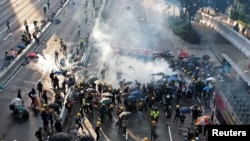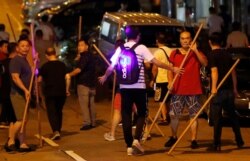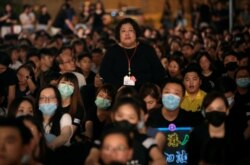Hong Kong's government struggled to quell a massive protest that morphed from a general strike into a fast moving, sometimes violent, multi-pronged fight against the government stretching from the city center to districts near mainland China.
Dozens of arrests and injuries were reported Monday as protesters threw gasoline bombs and police used tear gas and rubber bullets.
What began as a mass transit strike that halted trains and kept planes from taking off quickly morphed into street blockades, occupied tunnels, and attacks on police stations. Hong Kong police used tear gas on protesters who blocked highways and rampaged police stations.
Riot police also moved against peaceful protesters who filled a major highway celebrating the city’s first mass strike in decades. Anti-government activists struck back by throwing gasoline bombs in intersections and torching parts of a few government buildings.
One working class neighborhood that has battled police for days defied riot police, who fired tear gas and sponge grenades. So did protesters who persisted as police fired rubber bullets from the top floor of a police station in another suburban district.
On Hong Kong island, a group of men swinging long bamboo poles attacked protesters.
“The government has not responded to any of our concerns,” said Kellie, 22, a university research assistant, who attended what began as a peaceful protest at the government center and devolved into chaos as people fled riot police. “If they want to uphold the rule of law, they should take responsibility and not ignore the people’s voices.”
Carrie Lam, Hong Kong’s chief executive, once again refused to withdraw a hated bill that would allow criminal extraditions to mainland China. She also refused to agree to an investigation into the police force’s tactics that have included beating people and directly firing rubber bullets at peaceful protesters.
“Hong Kong is in a serious crisis,” Lam said at an early afternoon press conference. “Such extensive disruption in the name of certain demands or non-cooperative movements have seriously undermined Hong Kong law and order and are pushing our city, the city we all love, and many of us … to the verge of a very dangerous situation, … The great majority of Hong Kong people are in a state of great anxiety. … The government will be resolute in maintaining law and order and restoring confidence.”
Lam suspended action on the extradition bill weeks ago under great public pressure, but residents say they do not trust that she won’t raise it again. Their fury at the bill’s implication sparked the biggest protests and greatest political crisis in Hong Kong since the territory was relinquished by Britain to China in 1997. Anti-government forces have expanded their demands as they seek full voting rights that will give them more control over their government that currently bows to Beijing’s pressure.
Since June 12, when riot forces suppressed protesters who had taken over a highway, anti-government activists have worked hard to stage quicker, multi-pronged actions. Monday was such an example.
Protesters jammed the doors of commuter trains. They walked into tunnels and blocked drivers. They marched down commercial boulevards and through busy suburban neighborhoods, and filled Harcourt Road, one of the biggest highways in the city center. They jammed the commercial spine of Kowloon, Nathan Road, and highways in the city’s northwest, along with the Cross Harbor Tunnel, the major artery that ties Hong Kong Island to the rest of the city.
They were joined by workers and professional groups and unions who did not report to their jobs. Air traffic controllers called in sick to Hong Kong International Airport, forcing the authority to cancel more than 200 flights. Several major banks closed branches. The Hong Kong Confederation of Trade Unions, a group that favors democracy, asked its workers to strike.
By evening, the actions grew more provocative and dangerous, with multiple fires lit. Police fired tear gas in dense urban areas.
Protesters said they would continue to stage such actions until the government cedes to their five demands, which include a full withdrawal of a detested bill that would allow extradition to mainland China as well as an independent inquiry into the police department’s tactics.
Hong Kong’s struggling chief executive warned that the antigovernment protests were a direct challenge to Beijing’s authority and “very dangerous.” Lam said the demonstrations would ruin the semi-autonomous territory’s future. “We should all be very worried about this situation,” she said.
Audrey Eu, a lawyer and former lawmaker, said she worries that the protesters will burn themselves out before they achieve their aims. “But then, people keep coming,” she said.














